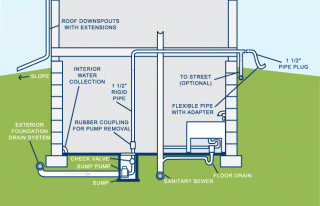Sump Pumps

Many homes have sump pumps to capture and remove groundwater that can cause a damp basement. Please consider the following tips if your home has a sump pump.
Tip 1 - Preseason check: If your sump pump does not run during winter, you should perform a test run before spring rains begin. Fill the sump pit with some water to make sure the pump is working. Visually check that the pump is actually discharging water (a faulty pump can run without pumping water). Listen for strange noises coming from the pump motor.
Tip 2 - Please don't break the rules: Sump pumps must discharge to the outside of your home and not-into the sanitary sewer (see illustration below). When a sump pump connects to a sanitary sewer line, it is called a cross-connection. Often this is a hose from the sump to a laundry tub or a floor drain. Water that goes down a drain in your house flows into the sanitary sewer system and to a wastewater treatment plant. The city is billed for every gallon of water discharged to the wastewater plant. The extra cost of that sump pump ends up being charged back to all customers in the city.
Tip 3 - Sump Hose Etiquette: Visually inspect the discharge hose and placement. Water should discharge out onto your lawn away from the outer wall of your home. Be a good neighbor; avoid discharging water into an adjacent property or extending hoses across public sidewalks or trails.

